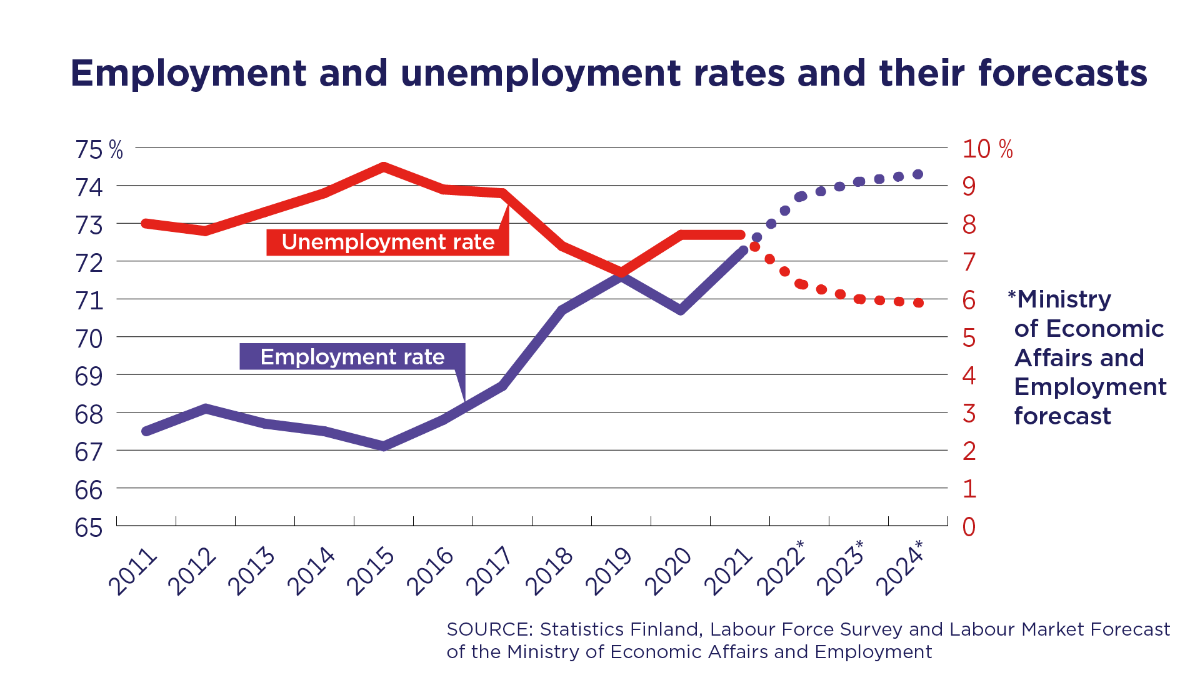Labour market forecast: Employment to grow further with more older people at work while unemployment falls

According to the labour market forecast extending until 2024, employment will improve in Finland. The number of employed people will continue to increase, but the rapid post-pandemic growth in employment is expected to slow down towards the end of 2023.
The employment rate of older people in particular seems to increase strongly while the decline in the number of long-term unemployed accelerates. This year, youth unemployment will shrink to the lowest level since the financial crisis in 2008. Employment will only grow in the service sector.
The information is based on the short-term labour market forecast published by the Ministry of Economic Affairs and Employment on 25 May 2022. Uncertainty is caused by the possible effects that Russia’s attack on Ukraine could have on the labour market. The forecast uses a series based on the new calculation method introduced in the Labour Force Survey at the beginning of the year 2021, which lowers the employment rate by about one percentage point.
“Although the economic forecast has had to be halved due to the war, robust employment growth will continue. I am particularly pleased about the decrease in long-term unemployment. It will have positive long-term effects on Finland’s dependency ratio and the sustainability of general government finances,” says Under-Secretary of State Elina Pylkkänen from the Ministry of Economic Affairs and Employment.
“Uncertainty related to the availability of labour may be reflected in willingness to invest. It is therefore important to make determined progress in the labour market roadmap project, in which eight sectoral groups seek solutions to the shortage of labour,” Pylkkänen says.
The labour force will grow by around 17 000 persons in 2022. This growth will slow down to 1 000 people in 2023 and 5 000 people in 2024. In addition to the economic upturn, the growth in the labour force participation rate will be driven by an increase in part-time work. However, the decrease in population will reduce the number of people in the labour force.
Employment growth at the beginning of this year has been strong, with the employment rate expected to rise to 73.7% in 2022 and to 74.1% in 2023. In 2024, the employment rate is forecast to reach 74.3%.
As employment increases sharply, the unemployment rate will fall to 6.4% in 2022. However, as employment growth slows, so will the fall in unemployment. The unemployment rate is forecast to drop to 6.0% in 2023 and to 5.9% in 2024.
The growth in part-time work has been robust, which in part explains the rapid increase in the number of employed people. In terms of full-time work, employment has grown more slowly and has only just reached the pre-pandemic level. According to the forecast, the share of part-time work of all work will no longer increase in the future. If it does, it will slow down the growth in the employment rate over the outlook period.
The employment rate will thus continue to rise considerably this year and unemployment will fall. However, the changes are minor compared to the previous forecast. Weaker economic growth caused by the war in Ukraine will slow the growth in employment, which was even better than expected in the first quarter of 2022.
The number of unemployed jobseekers in TE services will continue to fall steadily in the next few years. Long-term unemployment is projected to fall significantly faster than in the autumn 2021 forecast. In 2024, youth unemployment will drop to the lowest level since the recession in the 1990s, according to the forecast.
The short-term labour market forecast of the Ministry of Economic Affairs and Employment is based on a statistical time-series analysis that makes use of economic indicators, labour market statistics and policy information, as well as the Ministry of Finance’s GDP forecast and the demographic forecasts of Statistics Finland. The forecast is published twice a year.
Key forecast results:
| Year |
2022* |
2023* |
2024* |
| Employment rate |
73.7% |
74.1% |
74.3% |
| Unemployment rate |
6.4% |
6.0% |
5.9% |
| Labour force participation rate |
67.7% |
67.9% |
68.2% |
| Unemployed jobseekers |
247,000 |
227,000 |
213,000 |
| Long-term unemployed |
91,000 |
65,000 |
53,000 |
| Young unemployed jobseekers |
26,000 |
21,000 |
17,000 |
**forecast
Inquiries:
Elina Pylkkänen, Under-Secretary of State, Ministry of Economic Affairs and Employment, tel. +358 295 047 474
Johanna Alatalo, Ministerial Adviser, Ministry of Economic Affairs and Employment, tel. +358 50 516 3731 (labour demand, employment)
Erno Mähönen, Senior Specialist, Ministry of Economic Affairs and Employment, tel. +358 50 440 6081 (unemployed jobseekers)
Minna Ylikännö, Senior Specialist, Ministry of Economic Affairs and Employment, tel. +358 295 047 102 (labour supply, population)
Government employment measures and their impacts